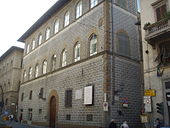Bardi (noble family)
The Florentine Bardi were one of the most important banking families in economic history with origins in the 12th century. They belonged to the typical patrician merchant families of the northern Italian city nobility .
history
The Bardi (the name is derived from the Celtic word bard ) are said to have lived in Florence as early as the 10th century. Between 1250 and 1345 the Bardi financed the kings of France and England with the Compagnia dei Bardi and had branches all over Europe. By coordinating financial and political activities, they became the leading banking house. The bank organized the financial processing of the papal tithe.
Bartolo de 'Bardi became prior of Florence in 1282. In 1287 Simone de 'Bardi married the banker's daughter Beatrice Portinari , a childhood friend of the poet Dante Alighieri . At the age of 24, she died in an epidemic. In his first work, Vita Nova, Dante lets the first-person narrator describe the inner changes that he went through as a result of his first childlike encounter with Beatrice, which he has adored ever since and beyond death. In his Divine Comedy , it is the figure of Beatrice in heaven who instructs the poet Virgil to lead the narrator (Dante) through the circles of hell and the purgatory, while she herself leads him through the nine heavenly spheres.
In 1332 Piero di Gualterotto Bardi bought the town and castle Vernio in Tuscany for 10,000 florins from Count Alberti from Prato , into whose family he had married. The branch of the Bardi di Vernio was formed , who also adopted the title of count associated with the property by Emperor Friedrich Barbarossa in 1164 . As a residence in Florence, the Bardi di Vernio bought Palazzo Bardi at 14 Via Santo Spirito, which had previously belonged to the Capponi and which they expanded considerably.
Most of the branches of the family were located in Via de 'Bardi in the Oltrarno district, to the left of the Arno, in particular in the Palazzo Bardi-Larioni (later called Canigiani) in Via de' Bardi 28-30 , which was built towards the end of the 14th century . In 1427 they owned 60 houses in the city, 45 of them in Oltrarno, most of which were inhabited by the numerous branches of the family themselves, including the Palazzo Bardi alla Postierla and the Palazzo Bardi-Tempi .
During the anti-patrician revolt of 1343, numerous Bardi houses were looted. Two years later, in 1345, the Compagnia dei Bardi bank went bankrupt. The support of the English King Edward III. (1327-1377) with a credit of 900,000 gold fiorentini in the Hundred Years War against France (1337-1453) turned out to be a disadvantage when the king stopped the payments. The Peruzzi family , which had committed 600,000 Fiorentini, was also affected . In May 1345 there was even an armed clash between the two competing families. By contrast, the Bardi had made peace with the powerful Buondelmonti family in 1342, which 130 male family members swore before a notary. According to the historian and Peruzzi partner Giovanni Villani, the defaulted loans "outweighed a kingdom".
Despite financial problems, the Bardis were able to achieve high positions such as ambassador posts in Rome. After the collapse, however, they rebuilt their banking business, albeit not with the previous scope and success. They also provided funding for Columbus and Cabot's expeditions . Around 1413/1415 Contessina de 'Bardi married the powerful banker Cosimo de' Medici , with whose Medici family the Bardi had been related by marriage in previous generations.
In 1482 Giovanni de 'Bardi acquired the Palazzo Bardi in Via de' Benci 5 , which remained in their possession until the family died out in 1964. His nephew Agnolo had it modernized in the Renaissance style.

In the Franciscan Church of Santa Croce , the Bardi, like many other merchant families, donated a burial chapel, the Bardi Chapel , which was painted with frescoes by Giotto and his school from 1315-20 . At the end of the 15th century, Agnolo Bardi commissioned Sandro Botticelli to create the famous altarpiece of Madonna Bardi for the family chapel in Santo Spirito , which is now in the Gemäldegalerie Berlin . From about 1576 to 1600 the artistic circle of the Florentine Camerata gathered around Count Giovanni de 'Bardi .
The main line of the Bardi family died out with Count Pier Maria Bardi in 1810. Heirs, including the Palazzo Bardi in Via Santo Spirito 14, were the Florentine Marchesi di Guicciardini. The side branch of the Counts Bardi of Vernio, on the other hand, only went out in 1964 with Alberto Bardi Serzelli, who bequeathed his fortune, including the Palazzo Bardi in Via de 'Benci 5, to his sister's family, the Marchesi Della Volta from Genoa, while a large part of his painting collection was in the Uffizi came.
See also
- Giovanni de 'Bardi (born February 5, 1534 in Florence, † 1612 in Rome ) was an Italian soldier , composer and poet
literature
- Edwin S. Hunt, The Medieval Super-Companies: A Study of the Peruzzi Company of Florence , p. 39
- Guidi-Bruscoli, F. (2012). "John Cabot and his Italian financiers *". Historical Research 85 (229): pp. 372-393. (engl.)
- Grazia Pernis, M .; Schneider Adams, L. (2008). Romaniello, MP, ed. "Lucrezia Tornabuoni de 'Medici and the Medici Family in the Fifteenth Century". The Historian 70 (2): pp. 389-390 (Eng.)
Individual evidence
- ↑ William Berdrow, book Famous merchants , men of energy and enterprising spirit portrayed in their lives underway, p 5 ff., Springer-Verlag, 11 November 2013
- ↑ Ephraim Russell, British History Online , The societies of the Bardi and the Peruzzi and their dealings with Edward III, pp. 93-135 (Eng.)
- ↑ Angelika Franz, Spiegel Online , Unearthed - News from Archeology: Italians Funded Discovery of North America, article from May 6, 2012
- ↑ Madonna Bardi




